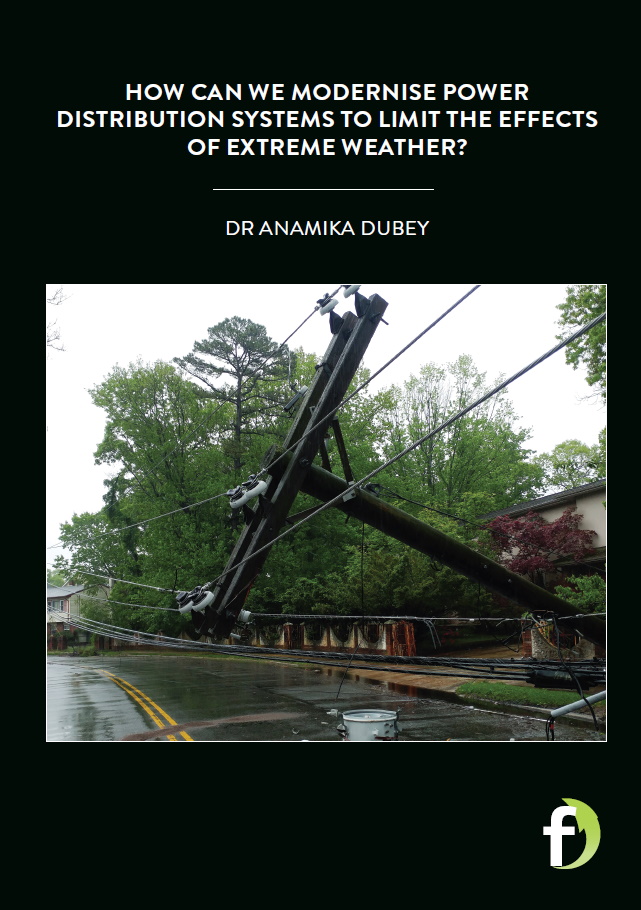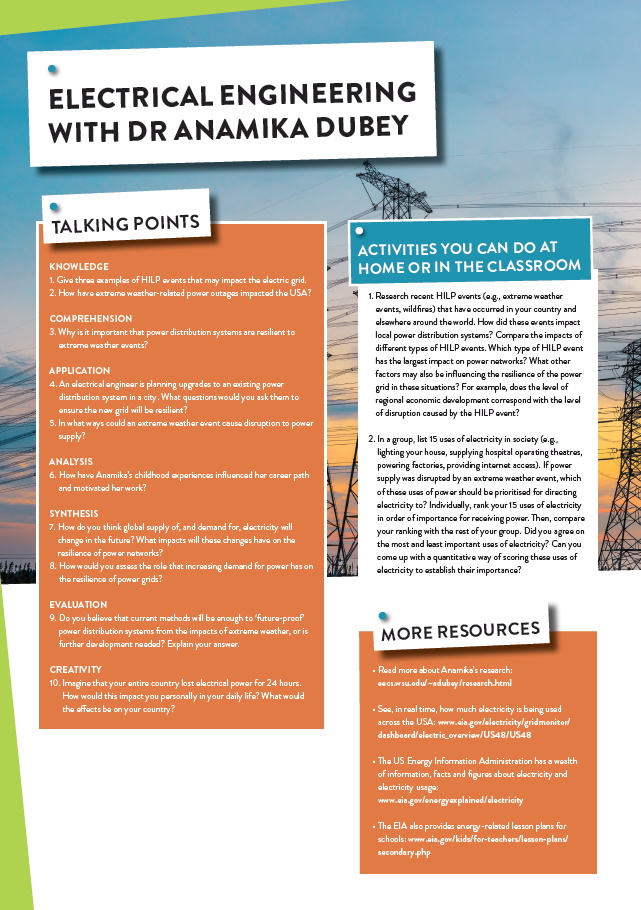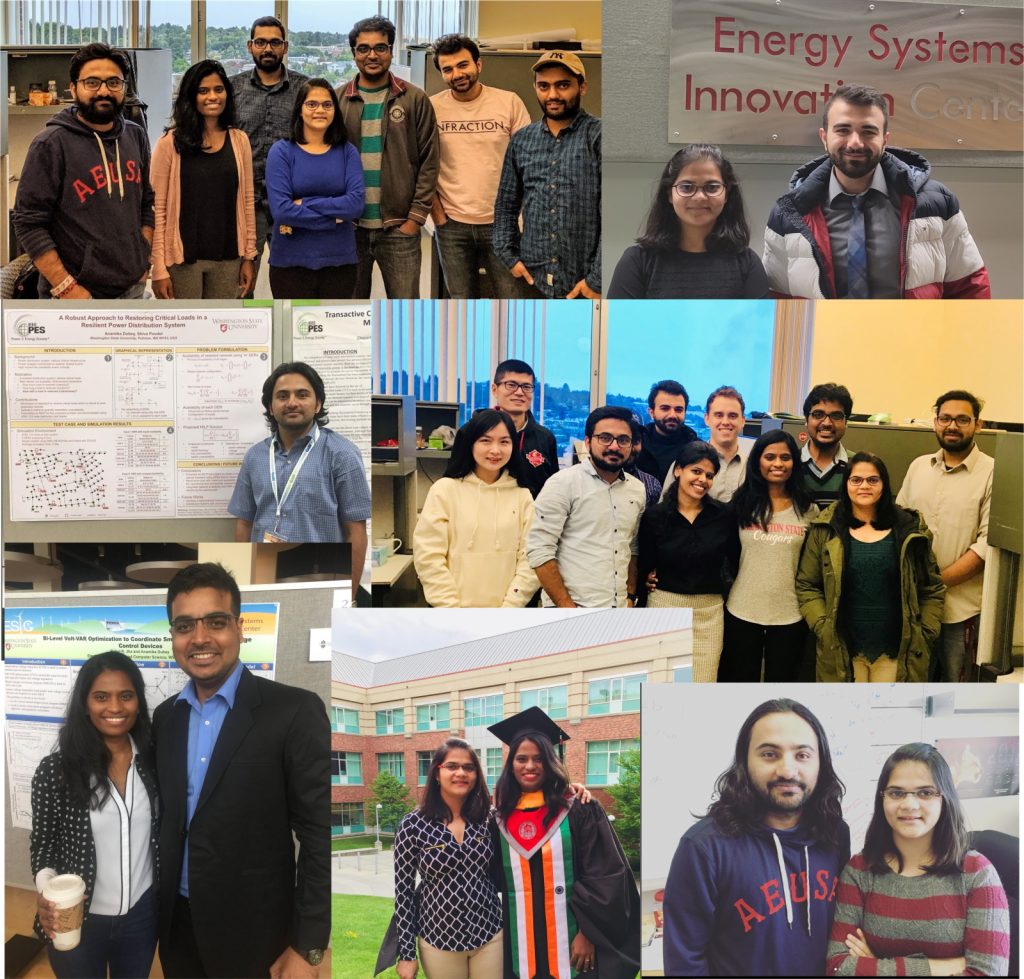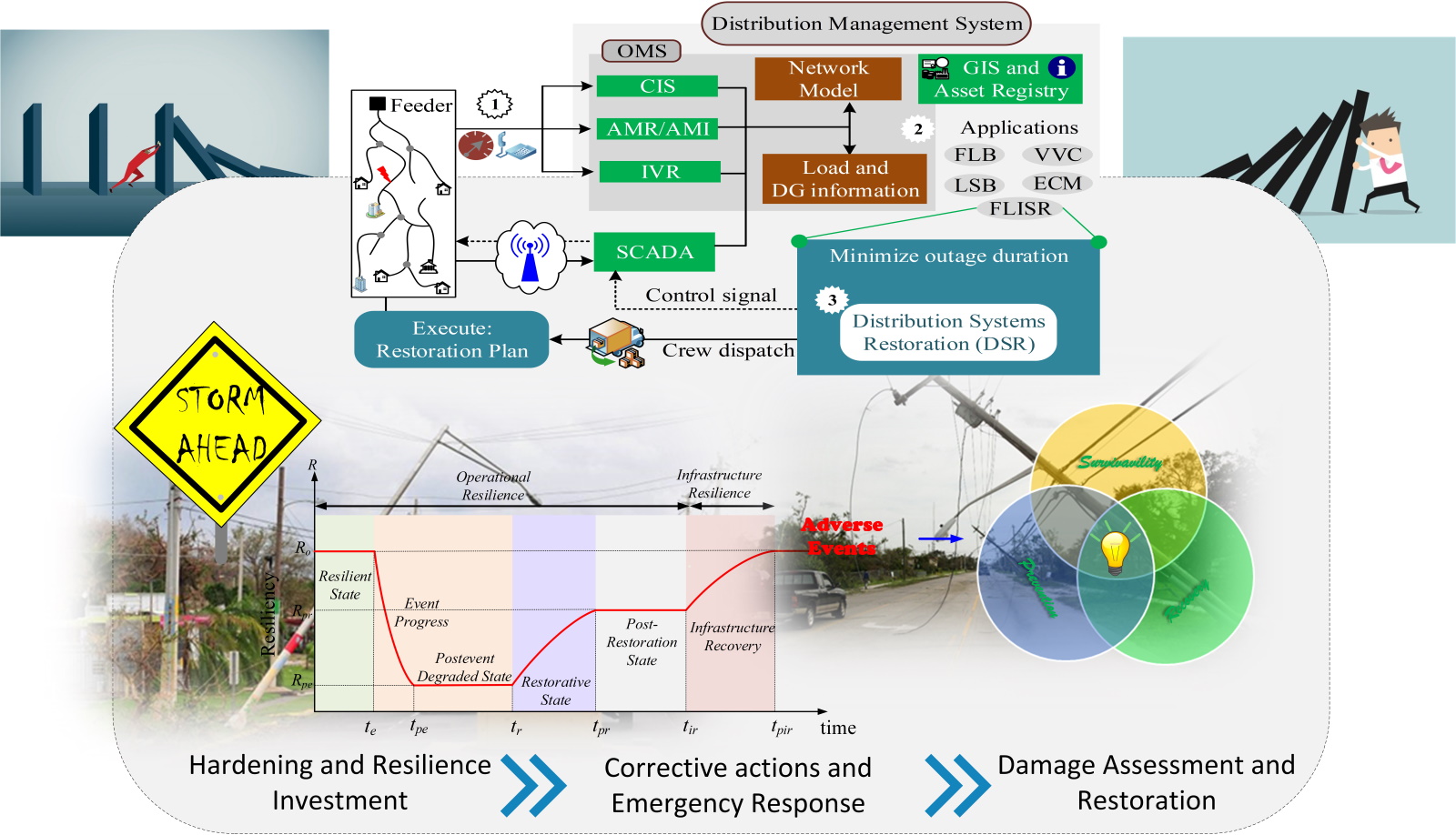How can we modernise power distribution systems to limit the effects of extreme weather?
Dr Anamika Dubey is an assistant professor with the School of Electrical Engineering and Computer Science at Washington State University in the USA. She is dedicated to improving the resilience of electric power grids to extreme weather events
TALK LIKE AN ELECTRICAL ENGINEER
BLACKOUT – a total loss of electrical power
BROWNOUT – a drop in voltage of electrical power
ELECTRIC GRID or POWER GRID – an interconnected network that delivers electrical power from producers (e.g., power stations) to consumers (e.g., individuals using electricity in their homes)
HIGH-IMPACT LOW-PROBABILITY (HILP) EVENT – an extreme event that does not occur very often
POWER OUTAGE – a loss of electrical power
STOCHASTIC MODELLING – a model that estimates the probability distribution of outcomes under different conditions by using random sampling of variables
We rely on electricity for almost all aspects of our modern lives. “The electric power grid is one of the nation’s most critical infrastructures,” explains Dr Anamika Dubey, an electrical engineer at Washington State University. “Virtually every system in modern society, from healthcare to transportation, water to communications, depends on electricity.” So, when this power infrastructure fails, it has serious consequences.
A loss in power for an extended period severely affects human well-being, the economy and even national security. During Hurricane Ida, in August-September 2021, about 1.2 million customers in northeastern USA were left without power.
EXTREME WEATHER EVENTS AND POWER OUTAGES
Hurricanes, severe storms and other extreme weather events have the potential to damage power grid infrastructure, such as power lines and poles, disrupting electricity supply to customers. The accompanying floods often prevent a rapid recovery of services, resulting in extended power outages. “In the aftermath of Hurricane Ida, it took almost 15 days to restore the electric power supply,” says Anamika.
“Approximately 78% of power outages from 1992 to 2012 in the USA can be attributed to extreme weather events,” Anamika adds. “These took a toll of $18-33 billion per year on the US economy, while affecting around 178 million metered customers.” As both the global demand for energy and the frequency of extreme weather events increase, the number of power outages, their economic costs and their human impacts will continue to grow.
Power stations and related infrastructure may be damaged by storms, preventing electricity from being supplied to customers. A disruption to power supply can also be caused by a lack of supply or excessive demand, both of which might take place during extreme weather events such as during unusually cold winters or hot summers. There might simply not be enough electricity generation, powerplants that have not been designed to withstand the weather conditions may be forced to shut, or excess demand can lead to overloading of the grid, resulting in power failure. Sometimes, power supply must be shut off for public safety, for example to reduce the risk of wildfires. “Wildfires ignited by the ageing and stressed power grid are costing billions of dollars annually,” says Anamika. “Power shut-offs to avoid these wildfires cause extended outages during the wildfire season and will only worsen due to rising global temperatures.”
HILP EVENTS
Although the electric power grid is designed to overcome known and credible threats of disruption, it is not resilient to rarer, more extreme disruptions, known as high-impact low-probability (HILP) events. HILP events happen infrequently but have the potential to cause unprecedented disruption of the power supply. These events include hurricanes, wildfires and winter storms. As the occurrence of these events becomes more frequent due to climate change, there is a pressing need to characterise and quantify their impacts on power grid infrastructure. “Rare events such as extreme weather continue to surprise us, so we must investigate new ways of managing their impacts on the grid and customers,” explains Anamika.
QUANTIFYING THE RISK OF HILP EVENTS
Anamika assesses the risk of power loss due to extreme weather events using computational models. “Our risk modelling framework uses event intensity models (such as profiles of regional wind speed) and component level fragility curves (the probability of grid components failing depending on event intensity),” she explains. “As expected, these probabilities increase sharply with the increase in weather intensity.”
As there is a stochastic element to weather intensity and its impact, Anamika uses ‘Monte-Carlo simulations’, which randomly sample data to produce more realistic models. These mathematical models allow her to evaluate the probabilistic impacts of weather events on the power grid infrastructure.
INCREASING GRID RESILIENCE
To reduce the extent of power outages, the resources needed to repair power infrastructure can be stockpiled to ensure they are easily available when the grid becomes damaged. Electrical engineers like Anamika are also working to reduce the risk of outages in the first place, by increasing the resilience of the grid.
Advances in smart grid technology are helping to ensure that power distribution networks are more resilient to HILP events. By creating ‘microgrids’ and using many different power generation sources, including local sources, smart grids can be made more resilient to outages. One solution to improve resilience in the grid is the formation of ‘intentional islands’, where the large-scale electric grid is separated into smaller units. During power outages, these islands can maintain the required voltage and frequency within a contained area, enabling a continuous power supply to vital services such as hospitals.
However, several technical challenges must be overcome to ensure reliable operation of these grid islands in the aftermath of extreme weather events. “Our approach entails distributed optimisation and control solutions to ensure feasible island formation and stable island operations for continuous supply to critical loads,” explains Anamika.
Reference
https://doi.org/10.33424/FUTURUM248
BLACKOUT – a total loss of electrical power
BROWNOUT – a drop in voltage of electrical power
ELECTRIC GRID or POWER GRID – an interconnected network that delivers electrical power from producers (e.g., power stations) to consumers (e.g., individuals using electricity in their homes)
HIGH-IMPACT LOW-PROBABILITY (HILP) EVENT – an extreme event that does not occur very often
POWER OUTAGE – a loss of electrical power
STOCHASTIC MODELLING – a model that estimates the probability distribution of outcomes under different conditions by using random sampling of variables
We rely on electricity for almost all aspects of our modern lives. “The electric power grid is one of the nation’s most critical infrastructures,” explains Dr Anamika Dubey, an electrical engineer at Washington State University. “Virtually every system in modern society, from healthcare to transportation, water to communications, depends on electricity.” So, when this power infrastructure fails, it has serious consequences.
A loss in power for an extended period severely affects human well-being, the economy and even national security. During Hurricane Ida, in August-September 2021, about 1.2 million customers in northeastern USA were left without power.
EXTREME WEATHER EVENTS AND POWER OUTAGES
Hurricanes, severe storms and other extreme weather events have the potential to damage power grid infrastructure, such as power lines and poles, disrupting electricity supply to customers. The accompanying floods often prevent a rapid recovery of services, resulting in extended power outages. “In the aftermath of Hurricane Ida, it took almost 15 days to restore the electric power supply,” says Anamika.
“Approximately 78% of power outages from 1992 to 2012 in the USA can be attributed to extreme weather events,” Anamika adds. “These took a toll of $18-33 billion per year on the US economy, while affecting around 178 million metered customers.” As both the global demand for energy and the frequency of extreme weather events increase, the number of power outages, their economic costs and their human impacts will continue to grow.
Power stations and related infrastructure may be damaged by storms, preventing electricity from being supplied to customers. A disruption to power supply can also be caused by a lack of supply or excessive demand, both of which might take place during extreme weather events such as during unusually cold winters or hot summers. There might simply not be enough electricity generation, powerplants that have not been designed to withstand the weather conditions may be forced to shut, or excess demand can lead to overloading of the grid, resulting in power failure. Sometimes, power supply must be shut off for public safety, for example to reduce the risk of wildfires. “Wildfires ignited by the ageing and stressed power grid are costing billions of dollars annually,” says Anamika. “Power shut-offs to avoid these wildfires cause extended outages during the wildfire season and will only worsen due to rising global temperatures.”
HILP EVENTS
Although the electric power grid is designed to overcome known and credible threats of disruption, it is not resilient to rarer, more extreme disruptions, known as high-impact low-probability (HILP) events. HILP events happen infrequently but have the potential to cause unprecedented disruption of the power supply. These events include hurricanes, wildfires and winter storms. As the occurrence of these events becomes more frequent due to climate change, there is a pressing need to characterise and quantify their impacts on power grid infrastructure. “Rare events such as extreme weather continue to surprise us, so we must investigate new ways of managing their impacts on the grid and customers,” explains Anamika.
QUANTIFYING THE RISK OF HILP EVENTS
Anamika assesses the risk of power loss due to extreme weather events using computational models. “Our risk modelling framework uses event intensity models (such as profiles of regional wind speed) and component level fragility curves (the probability of grid components failing depending on event intensity),” she explains. “As expected, these probabilities increase sharply with the increase in weather intensity.”
As there is a stochastic element to weather intensity and its impact, Anamika uses ‘Monte- Carlo simulations’, which randomly sample data to produce more realistic models. These mathematical models allow her to evaluate the probabilistic impacts of weather events on the power grid infrastructure.
INCREASING GRID RESILIENCE
To reduce the extent of power outages, the resources needed to repair power infrastructure can be stockpiled to ensure they are easily available when the grid becomes damaged. Electrical engineers like Anamika are also working to reduce the risk of outages in the first place, by increasing the resilience of the grid.
Advances in smart grid technology are helping to ensure that power distribution networks are more resilient to HILP events. By creating ‘microgrids’ and using many different power generation sources, including local sources, smart grids can be made more resilient to outages. One solution to improve resilience in the grid is the formation of ‘intentional islands’, where the large-scale electric grid is separated into smaller units. During power outages, these islands can maintain the required voltage and frequency within a contained area, enabling a continuous power supply to vital services such as hospitals.
However, several technical challenges must be overcome to ensure reliable operation of these grid islands in the aftermath of extreme weather events. “Our approach entails distributed optimisation and control solutions to ensure feasible island formation and stable island operations for continuous supply to critical loads,” explains Anamika.
Traditionally, decision making in power distribution systems is made centrally, but this leaves the system vulnerable to single-point failure, cyber-attacks, communication failures and computational challenges. Therefore, Anamika is developing a distributed decision-making paradigm where multiple agents solve smaller sub-problems and jointly coordinate their individual decisions to achieve network-level objectives. “This approach is robust to failures, allows autonomous control of power distribution, and has comparatively low computing cost compared to large centralised systems,” Anamika says.
“Traditional planning and operational solutions for resilience are limited, due to inadequate characterisation of HILP events and overly simplified models,” Anamika explains. Resilient power networks must use risk modelling frameworks to simulate the trajectories of extreme events and quantify their impacts through time. By using data-driven, simulation-based frameworks and improved sampling techniques, Anamika can effectively model the time-varying impacts of HILP events on power grids. The next step will be to develop more comprehensive climate-impact models for power grid devices, as well as systems and scalable solutions for climate-adaptation of the large-scale regional and national electric power grid.
As climate change increases the frequency and intensity of extreme weather events and the world has an ever-increasing demand for electricity, electrical engineers such as Anamika are vital for ensuring that electrical grids are resilient so that we have uninterrupted access to power supplies.
DR ANAMIKA DUBEY 
Washington State University, Pullman, USA
FIELDS OF RESEARCH: Electrical Engineering, Electric Power Systems
RESEARCH PROJECT: Improving resilience of power distribution systems against extreme weather events
FUNDERS: National Science Foundation (NSF), Department of Energy, Pacific Northwest National Laboratories
DR ANAMIKA DUBEY 
Washington State University, Pullman, USA
FIELDS OF RESEARCH: Electrical Engineering, Electric Power Systems
RESEARCH PROJECT: Improving resilience of power distribution systems against extreme weather events
FUNDERS: National Science Foundation (NSF), Department of Energy, Pacific Northwest National Laboratories
ABOUT ELECTRICAL ENGINEERING
Electrical engineers study the applications of mathematics and physics in all electrical, electronic or computer-based devices and systems. They apply fundamental principles of electromagnetism, electronics and electricity to design and operate many valuable systems, such as power networks, telecommunications and satellite communications.
As Anamika investigates the impacts of extreme weather events on power systems, she requires an interdisciplinary set of skills and knowledge. She needs an understanding of meteorology, climate modelling and data science, alongside her knowledge of electric power infrastructure systems. “Most research related to the power grid is done on computer-generated models, so an expertise in computer programming is a must,” Anamika adds. “Moreover, as we are working with large-scale complex systems, expertise in large-scale computing, mathematical optimisation techniques and data-driven analytics are all crucial.”
WHAT IS REWARDING ABOUT WORKING AS AN ELECTRICAL ENGINEER?
“The impacts of electrical engineers are visible in every aspect of our modern lives, from access to electric power, modern medicine and the internet, to shuttling us to the farthest reaches of the universe,” says Anamika. Research in electrical engineering aims to improve our day-to-day lives. “I find my job deeply satisfying, knowing that I am contributing to making this world a better place every day,” Anamika says.
WHAT CHALLENGES WILL FACE THE NEXT GENERATION OF ELECTRICAL ENGINEERS?
The demand for electricity worldwide will continue to increase in the coming decades, however, it is essential that this increasing demand is met by energy that is produced without negative impacts on our precious planet. Future electrical engineers will design innovative ways to increase our use of renewable energy, including improving storage technologies and integrating them into the grid. They will also modernise the grid itself, improving its efficiency through use of digital technologies. This means they will have to manage associated cybersecurity challenges. With so much technological innovation required to ensure the world has access to electricity, Anamika says, “The future for electrical engineers in the area of power and energy is very exciting!”
EXPLORE A CAREER IN ELECTRICAL ENGINEERING
• Anamika recommends joining the Institution of Electrical and Electronics Engineers (www.ieee.org), one of the largest societies of electrical and electronics engineers. The IEEE Learning Network provides courses in areas such as power and energy, telecommunications, emerging technologies, and computing, allowing you to explore the wide range of topics studied by electrical engineers.
• The Institute of Engineering and Technology (www.theiet.org) also provides information and opportunities related to electrical engineering.
• Electrical Careers (www.electricalcareers.co.uk) has a wealth of information on careers, qualifications and apprenticeships in the electricity industry.
• According to Glassdoor, the estimated salary for an entry-level research electrical engineer in the USA is around $99,000: www.glassdoor.com/Salaries/electrical-engineer-research-salary-SRCH_KO0,28.htm
PATHWAY FROM SCHOOL TO ELECTRICAL ENGINEERING
• At school, Anamika recommends developing strong analytical skills by studying maths and science, especially physics. She also recommends taking courses related to computer programming to understand the basic principles of code development.
• Many universities offer degrees in electrical engineering. Anamika suggests taking courses in advanced maths and physics, electromagnetics, electric circuits, electronics, and signals and systems.
• As you progress through an electrical engineering degree, you can specialise in the specific fields that interest you, such as electric power, microelectronics, communication systems, etc.
• Electrical engineers who work in industry rather than academia often pursue apprenticeships or vocational qualifications.
HOW DID ANAMIKA BECOME AN ELECTRICAL ENGINEER?
I spent my childhood in a small town in central India, where my family greatly valued education and encouraged me to pursue excellence. From an early age, I was fascinated by all types of machines, I had a knack for maths and science, and was curious to learn more about the world. Luckily, my family nurtured my curiosity, and a supportive environment motivated me to pursue a bachelor’s degree in engineering from one of the premier institutions in India and, consequently, master’s and doctorate degrees in the USA. Throughout my journey, my grandfather (‘Nana’) has been a great source of support.
My interest in engineering was a by-product of my father working as an engineer, and the fact I always enjoyed and achieved in maths and physics at school. My maths and physics teachers guided me through the process of getting into the top engineering college in India.
My mother, who is a doctor, has been the greatest source of strength and inspiration. She constantly inspired and motivated me not to be defeated by circumstances and to choose my own path in life.
I grew up in an era when a major part of rural India did not have access to regular electricity supply, and urban India experienced frequent blackouts and brownouts. Having experienced this problem first-hand, I decided to work on improving the electric power grid infrastructure. This led to further interest in renewable energy resources and their value towards a sustainable energy future, and motivated me to pursue a university professorship in electric power systems.
As a student, I undertook internships with the Defence Research Development Organization of the Government of India, and with the Mitsubishi Electric Research Laboratories in the USA. My internships provided an opportunity to learn about how theoretical principles are applied in the real world. In school, we learn mostly about theory and principles of engineering with less focus on real-world applications. All my internships provided me with valuable experience and helped me to develop a deeper appreciation for the field by seeing its direct application to the real world. I think internships during college are crucial for the development of a well-rounded engineer.
Our electricity infrastructure is a technological marvel. We may take it for granted, but it needs our collective attention if we are to continue to reap the benefits of electric power while not damaging our environment beyond the point of no return. Thus, we need to pay attention to where our power is coming from. While energy conservation at an individual level is great, we need to make our politicians understand the need for clean power and push for progressive policies that will lead to a more sustainable energy future.
When not working, I love to hike and spend time with my husband. I am lucky to have a partner who values my career aspirations and continuously supports, encourages and inspires me. I also enjoy catching up on regional, national and international politics on several issues related to energy, sustainability and technology.
Follow your passion and find the time to act on what you think is important. Most of the hours of your life will be spent working. Why not work on something that you truly enjoy?
Do you have a question for Anamika?
Write it in the comments box below and Anamika will get back to you. (Remember, researchers are very busy people, so you may have to wait a few days.)










